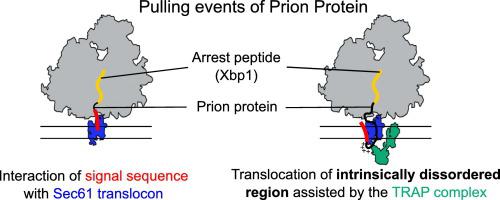Journal of Molecular Biology ( IF 4.7 ) Pub Date : 2020-06-02 , DOI: 10.1016/j.jmb.2020.05.022 Theresa Kriegler 1 , Sven Lang 2 , Luigi Notari 3 , Tara Hessa 1

|
The mammalian prion protein (PrP) engages with the ribosome–Sec61 translocation channel complex to generate different topological variants that are either physiological, or involved in neurodegenerative diseases. Here, we describe cotranslational folding and translocation mechanisms of PrP coupled to an Xbp1-based arrest peptide as folding sensor, to measure forces acting on PrP nascent chain. Our data reveal two main pulling events followed by a minor third one exerted on the nascent chains during their translocation.
Using those force landscapes, we show that a specific sequence within an intrinsically disordered region, containing a polybasic and glycine-proline rich residues, modulates the second pulling event by interacting with TRAP complex. This work also delineates the sequence of events involved in generation of PrP toxic transmembrane topologies during its synthesis. Our results shed new insight into the folding of such a topological complex protein, where marginal pulling by the signal sequence, together with the flanking downstream sequence in the mature domain, primarily drives an overall inefficient translocation resulting in the nascent chain to adopt alternative topologies.
中文翻译:

拉力研究揭示朊病毒蛋白易位机制。
哺乳动物朊病毒蛋白 (PrP) 与核糖体-Sec61 易位通道复合物结合,产生不同的拓扑变异,这些变异要么是生理性的,要么与神经退行性疾病有关。在这里,我们描述了 PrP 与基于 Xbp1 的阻滞肽偶联作为折叠传感器的共翻译折叠和易位机制,以测量作用于 PrP 新生链的力。我们的数据揭示了两个主要的拉动事件,随后是新生链在易位过程中施加的第三次较小的拉动事件。
利用这些力景观,我们表明,本质上无序区域内的特定序列(包含多元和富含甘氨酸-脯氨酸的残基)通过与 TRAP 复合物相互作用来调节第二个牵引事件。这项工作还描述了合成过程中 PrP 有毒跨膜拓扑结构生成所涉及的事件顺序。我们的结果为这种拓扑复杂蛋白质的折叠提供了新的见解,其中信号序列的边缘拉动以及成熟结构域中的侧翼下游序列主要驱动整体低效易位,导致新生链采用替代拓扑。











































 京公网安备 11010802027423号
京公网安备 11010802027423号